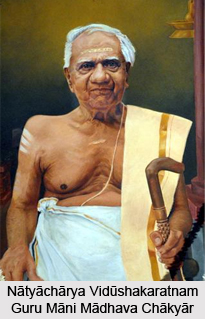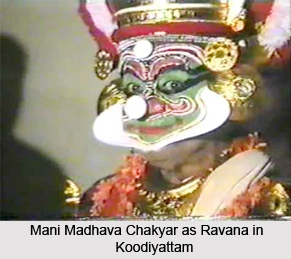 Guru Mani Madhava Chakyar was a prominent celebrated Indian master performance artist, who was considered the greatest exponent and performer of ancient Sanskrit theatre art forms Koodiyattam and Chakyar Koothu, of the modern times. He was also regarded as the authority of Natyashastra, sage Bharata Muni"s compiled Sanskrit Hindu text on performing arts, as well as the art of expression Abhinaya. His exceptional ability to perform Rasa-Abhinaya and Netrabhinaya was world famous and he could act by expressing only through eyes. He was a Sanskrit scholar well versed in all the traditional Koodiyattams and all the "prabandhas" used in Chakyar Koothu. He was the first one to take these art forms outside the precincts of the Kerala theatre temples to all over India, and to impart training in Koodiyattam to non-Chakyar disciples including foreigners. He has authored "Natyakalpadrumam", an encyclopaedic treatise on all aspects of Koodiyattam. The maestro with Painkulam Damodara Chakyar and Ammannur Madhava Chakyar were considered the trinity of Koodiyattam. They were instrumental in popularizing this centuries old theatrical form and getting it recognised by UNESCO. He was also a Fellow of national art academies including Sangeet Natak Akademi and a recipient of coveted titles like "Natyacharya", "Vidushakaratnam" and awards including the Padma Shri and the Sangeet Natak Akademi Award.
Guru Mani Madhava Chakyar was a prominent celebrated Indian master performance artist, who was considered the greatest exponent and performer of ancient Sanskrit theatre art forms Koodiyattam and Chakyar Koothu, of the modern times. He was also regarded as the authority of Natyashastra, sage Bharata Muni"s compiled Sanskrit Hindu text on performing arts, as well as the art of expression Abhinaya. His exceptional ability to perform Rasa-Abhinaya and Netrabhinaya was world famous and he could act by expressing only through eyes. He was a Sanskrit scholar well versed in all the traditional Koodiyattams and all the "prabandhas" used in Chakyar Koothu. He was the first one to take these art forms outside the precincts of the Kerala theatre temples to all over India, and to impart training in Koodiyattam to non-Chakyar disciples including foreigners. He has authored "Natyakalpadrumam", an encyclopaedic treatise on all aspects of Koodiyattam. The maestro with Painkulam Damodara Chakyar and Ammannur Madhava Chakyar were considered the trinity of Koodiyattam. They were instrumental in popularizing this centuries old theatrical form and getting it recognised by UNESCO. He was also a Fellow of national art academies including Sangeet Natak Akademi and a recipient of coveted titles like "Natyacharya", "Vidushakaratnam" and awards including the Padma Shri and the Sangeet Natak Akademi Award.
Early Life and Education of Mani Madhava Chakyar
A member of the Puthiyedath Chakyar clan, Mani Madhava Chakyar was born in a village near Quilandy in old Malabar, Kerala on February 15, 1899, into the Mani family of Chakyars of North Kerala, who for centuries have been the custodians of Koodiyattam, the traditional Sanskrit theatre and classical art form Chakyar Koothu. Madhava Chakyar had his early training with his mother, Kuniyil Narayanan Nambisan, whom he lost at the age of 9, and thereafter with his uncles, Mani Neelakanta Chakyar, Parameswara Chakyar and Narayana Chakyar. Along with his studies in Indian classical dance, he also learnt Sanskrit from Pannisseri Sankaran Nambudripad and Tarka Sastra and Vedanta from H. H. Rama Varma Parikshit Tampuran of Cochin.
On-Stage Performances of Mani Madhava Chakyar
Madhava Chakyar had his "arangetram", i.e., debut on-stage performance, at the age of 11 in Tiruvangayoor Siva temple. From then on, he began performing regularly in various temples. His family had hereditary rights to perform in 40 temples in north and central Kerala. Some of them allowed only Chakyar Koothu to be performed under their auspices, while others encouraged the entire gamut of Koodiyattam, including the ritualistic performance of Anguliankam and Mathavilasam. Madhava Chakyar won high renown for the artistry of his performance in these temples. His forte was Netrabhinaya, the expressive use of eyes to demonstrate a wide range of emotions.
In 1955, Guru Mani Madhava Chakyar became the first one to perform Koodiyattam outside the precincts of temple theatres. For performing the art form outside the temples, he faced many problems from the hardline Chakyar community. He has taken the art forms of Koodiyattam and Koothu beyond the temple theatres of Kerala, so that they could survive the test of time. In 1962, under the leadership of Dr. V. Raghavan, noted art and Sanskrit scholar, the Sanskrit Ranga of Madras (erstwhile Chennai) invited Guru Mani Madhava Chakyar to perform Koodiyattam in Chennai. Thus, for the first time in history, Koodiyattam was performed outside Kerala. They presented at Madras on three nights, Kutiyattam scenes from three plays - "Abhiseka", "Subhadradhanañjaya" and "Naganda". The performance of the maestro Mani Madhava Chakyar had a great impact on the people and art critics. People outside Kerala were able to witness his talent. Then he was invited and performed Koodiyattam at places in North India like New Delhi and Banaras (erstwhile Varanasi). It made the critics accept his authority in Rasa Abhinaya, Natyashastra and Kutiyattam.
After Chakyar`s first tour in New Delhi, he was immediately conferred the Sangeet Natak Akademi Award in 1964 for his "contributions to Chakyar Koothu and Kutiyattam". This was the first national recognition to the maestro and the art form. His supremacy in Rasa-abhinaya, Netrabhinaya and Kutiyattam attracted lot of people towards the art form. He performed Koodiyattam all over India and popularized the ancient Sanskrit theatrical art. He and his troupe gave Koodiyattam performances in Madras (1962, 1973 and 1977), Mathura (1962), New Delhi (1964, 1966, 1974, 1979 and 1983), Varanasi (1964 and 1979), Bombay (1973), Ujjain (1982), Bhopal (1987) and in many other places.
 The President of India, scholar and philosopher Dr. Sarvepalli Radhakrishnan invited him to perform Koodiyattam at the Rashtrapati Bhavan in 1964 and was impressed by the Guru`s exceptional acting prowess. His Koodiyattam performances, lectures and demonstrations at centres like Madras Music Academy in Chennai, International Centre for Kathakali in New Delhi, Experimental Theatre in New Delhi and Bombay and National Centre for the Performing Arts in Bombay fetched wide popularity and recognition for his Abhinaya and Koodiyattam. He choreographed and directed acts of the plays like Kalidasa`s "Abhijnanasakuntalam", "Vikramorvasiya" and "Malavikagnimitra", Bhasa`s "Swapnavasavadatta" and "Pancharatra", Harsha`s "Naganandam", for the first time in the history of Koodiyattam. He also performed Chakyar Koothu and Koodiyattam for All India Radio and Doordarshan for the first time, which helped to attract thousands of listeners and a wider range of viewers to these traditional art forms.
The President of India, scholar and philosopher Dr. Sarvepalli Radhakrishnan invited him to perform Koodiyattam at the Rashtrapati Bhavan in 1964 and was impressed by the Guru`s exceptional acting prowess. His Koodiyattam performances, lectures and demonstrations at centres like Madras Music Academy in Chennai, International Centre for Kathakali in New Delhi, Experimental Theatre in New Delhi and Bombay and National Centre for the Performing Arts in Bombay fetched wide popularity and recognition for his Abhinaya and Koodiyattam. He choreographed and directed acts of the plays like Kalidasa`s "Abhijnanasakuntalam", "Vikramorvasiya" and "Malavikagnimitra", Bhasa`s "Swapnavasavadatta" and "Pancharatra", Harsha`s "Naganandam", for the first time in the history of Koodiyattam. He also performed Chakyar Koothu and Koodiyattam for All India Radio and Doordarshan for the first time, which helped to attract thousands of listeners and a wider range of viewers to these traditional art forms.
Teaching Endeavours by Mani Madhava Chakyar
Mani Madhava Chakyar was also the first to start demonstrations in Koodiyattam, to popularise the same. In early 1960s, Maria Christopher Byrski, a Polish student doing research in Indian theatres at Banaras Hindu University, came to study Koodiyattam from the maestro and became the first non-Chakyar/Nambiar to master the art form. He stayed in Guru`s home at the Killikkurussimangalam (also known as Lakkidi) village and studied the art form in the traditional Gurukula way.
Chakyar also taught at Kerala Kalamandalam where he trained advanced students in Kathakali and Koodiyattam. He taught Kathakali also at the P. S.V. Natya Sangham in Kottakkal and the Gandhi Sevasadanam in Perur. For some time, he also taught Sanskrit at the Sanskrit school in Lakkidi. Many of his students, including some of his sons and nephews, went on to become proficient performers in their own right in Kathakali and Koodiyattam. Some of them are Kalamandalam Krishnan Nair, Kalamandalam Ramankutty Nair, sons P. K. Narayanan Nambiar and P. K. G. Nambiar, nephews Neelakantan Chakyar and Damodara Chakyar, and another foreigner Farley Richmond, from America.
Publications of Mani Madhava Chakyar
In 1975, Mani Madhava Chakyar published "Natyakalpadrumam", a comprehensive treatise in Malayalam on Koodiyattam. Hailed as the most authoritative book on the subject, it deals with all aspects of Koodiyattam and is as important for the scholar as for the interested layman. Other works of his include "Mathavilasam", a branch of Koodiyattam, and stage manual for the third act of "Naganandam" and the second and third acts of "Sakuntalam".
Awards and Recognitions received by Mani Madhava Chakyar
The maestro of Koodiyattam and Chakyar Koothu has been conferred many awards and honours, including the titles "Natyacharya" and "Vidushakaratnam". He has received major national and international awards and fellowships:
•Sangeet Natak Akademi Award - first national recognition for a Koodiyattam/Chakyar Koothu artist, 1964
•Paderewski Foundation (New York) Certificate of Merit - first international recognition for Koodiyattam, 1964
•Padma Shri, India"s fourth highest civilian honour, 1974
•Kerala Sahitya Academy Award for the book "Natyakalpadrumam", 1975
•Kerala Sangeet Natak Academy Fellowship, 1975
•Sangeet Natak Akademi Fellowship, 1982
•Government of India Emeritus Fellowship, 1982
•Kalidasa Academy Fellowship (Ratna Sadasyata), 1982
•Kerala Kalamandalam Fellowship, 1983
•Tulsi Samman from Government of Madhya Pradesh, 1987
•Guruvayoor Devaswam Award, 1991
There have been many films and documentaries made on Mani Madhava Chakyar, featuring the legend"s Rasa-Abhinaya, Koodiyattam performances and illustrious life. The most significant one is "Mani Madhava Chakyar: The Master at Work", directed by Kavalam Narayana Panikar and distributed by the Sangeet Natak Akademi, New Delhi. It is a biographical film on the life and work of the artist, in English.
Guru Mani Madhava Chakyar died on January 14, 1990, at the age of 90, in a private hospital at Ottappalam due to natural causes. His body was cremated with full honours at his residence in Lakkidi. There is a memorial to the Guru at the spot of his cremation.
Related Articles:
Sanskrit Language
Forms of Indian Theatre
Kerala
Folk Theatre of Kerala
Sanskrit Theatre
Classical Indian Dance Drama
Koothu
Abhinaya, Indian Art Form
Natyashastra
Bharata Muni
Ammannur Madhava Chakyar
Indian Classical Dance




















